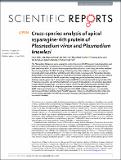Files in this item
Cross-species analysis of apical asparagine-rich protein of Plasmodium vivax and Plasmodium knowlesi
Item metadata
| dc.contributor.author | Muh, Fauzi | |
| dc.contributor.author | Ahmed, Md Atique | |
| dc.contributor.author | Han, Jin-Hee | |
| dc.contributor.author | Nyunt, Myat Htut | |
| dc.contributor.author | Lee, Seong-Kyun | |
| dc.contributor.author | Lau, Yee Ling | |
| dc.contributor.author | Kaneko, Osamu | |
| dc.contributor.author | Han, Eun-Taek | |
| dc.date.accessioned | 2019-07-17T14:30:08Z | |
| dc.date.available | 2019-07-17T14:30:08Z | |
| dc.date.issued | 2018-04-10 | |
| dc.identifier | 259650820 | |
| dc.identifier | 24e7b8cf-ca73-42a7-9224-3640d6ac5ba6 | |
| dc.identifier | 000429680400009 | |
| dc.identifier | 85045244248 | |
| dc.identifier.citation | Muh , F , Ahmed , M A , Han , J-H , Nyunt , M H , Lee , S-K , Lau , Y L , Kaneko , O & Han , E-T 2018 , ' Cross-species analysis of apical asparagine-rich protein of Plasmodium vivax and Plasmodium knowlesi ' , Scientific Reports , vol. 8 , 5781 . https://doi.org/10.1038/s41598-018-23728-1 | en |
| dc.identifier.issn | 2045-2322 | |
| dc.identifier.other | ORCID: /0000-0002-3966-9110/work/59698780 | |
| dc.identifier.uri | https://hdl.handle.net/10023/18113 | |
| dc.description.abstract | The Plasmodium falciparum apical asparagine (Asn)-rich protein (AARP) is one of malarial proteins, and it has been studied as a candidate of malaria subunit vaccine. Basic characterization of PvAARP has been performed with a focus on its immunogenicity and localization. In this study, we further analyzed the immunogenicity of PvAARP, focusing on the longevity of the antibody response, cross-species immunity and invasion inhibitory activity by using the primate malaria parasite Plasmodium knowlesi. We found that vivax malaria patient sera retained anti-PvAARP antibodies for at least one year without re-infection. Recombinant PvAARP protein was strongly recognized by knowlesi malaria patients. Antibody raised against the P. vivax and P. knowlesi AARP N-termini reacted with the apical side of the P. knowlesi merozoites and inhibited erythrocyte invasion by P. knowlesi in a concentration-dependent manner, thereby suggesting a cross-species nature of anti-PvAARP antibody against PkAARP. These results can be explained by B cell epitopes predicted in conserved surface-exposed regions of the AARP N-terminus in both species. The long-lived anti-PvAARP antibody response, cross-reactivity, and invasion inhibitory activity of anti-PvAARP support a critical role of AARP during the erythrocyte invasion and suggest that PvAARP induces long-lived cross-species protective immunity against P. vivax and P. knowlesi. | |
| dc.format.extent | 11 | |
| dc.format.extent | 1844937 | |
| dc.language.iso | eng | |
| dc.relation.ispartof | Scientific Reports | en |
| dc.subject | QH301 Biology | en |
| dc.subject | RC Internal medicine | en |
| dc.subject | NDAS | en |
| dc.subject | SDG 3 - Good Health and Well-being | en |
| dc.subject.lcc | QH301 | en |
| dc.subject.lcc | RC | en |
| dc.title | Cross-species analysis of apical asparagine-rich protein of Plasmodium vivax and Plasmodium knowlesi | en |
| dc.type | Journal article | en |
| dc.contributor.institution | University of St Andrews. School of Medicine | en |
| dc.identifier.doi | 10.1038/s41598-018-23728-1 | |
| dc.description.status | Peer reviewed | en |
This item appears in the following Collection(s)
Items in the St Andrews Research Repository are protected by copyright, with all rights reserved, unless otherwise indicated.

